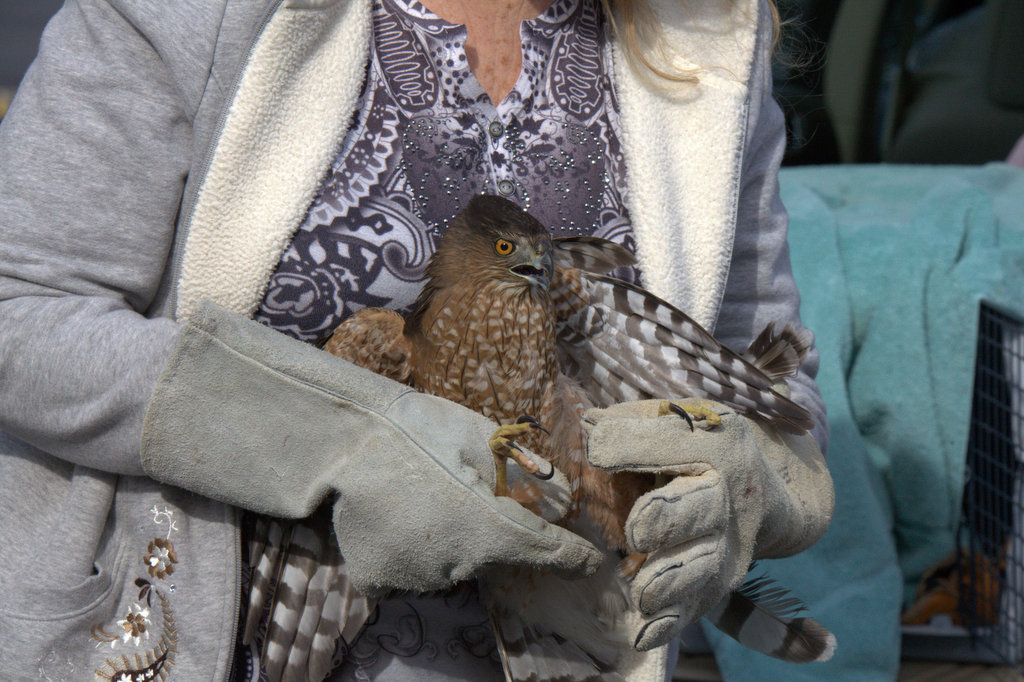'Art' - the Ad-Art Cooper's Hawk
Photographer and friend, Bill Lavallie, called me because there was a hawk who had flown into
Ad Art in Jackson to eat a meal of pigeon. What was concerning Bill and the kind folks at Ad Art
most was how to safely get this hawk to exit.
Bill had also called Tri County Wildlife Care a Raptor Team Leader, Pat Benik, who told him to
do exactly what they had already done, open all doors and windows and shut off all lights so the
outside appears to be more light.
Unfortunately this bird slammed into something as he exited, cutting open his crop. The crop is
a sack on the chest of most birds which holds the food and where digestion begins.
Pat Benik took this bird into her care and get it to our Avian vet, Dr. Jeanne Smith, the following
day. Dr. Smith stitched up the crop and gave TCWC antibiotics with instructions that if all went
well, the bird could be released back I to the wild in just 10 days.
Birds have high temperatures, about 104 degrees and high metabolism. This allows them to
heal incredibly quickly. Bones can heal in 5-7 days as well, so we try to get birds Into care as
quickly as possible because their fragile, hollow bones must be set properly soon after injury for
future flight to be possible.
This bird is a Cooper's Hawk and pigeon is one of his favorite meals. They are known for agility
in flight which allows them to chase birds through trees at high speeds.
Female Cooper's Hawks are much larger than the males so since they are adept at eating
medium sized birds, males are careful to listen for a call indicating a female is a willing mate
before approaching.
Pat contacted everyone who was involved in getting this bird into care for what we at Tri County
Wildlife Care call our"payday", the release of this bird back into the wild. I checked with Mike
Daly to get his permission to release this bird back into Jackson. Because this bird eats
pigeons, Mike was glad to have him back. This bird took off immediately.
Ad Art in Jackson to eat a meal of pigeon. What was concerning Bill and the kind folks at Ad Art
most was how to safely get this hawk to exit.
Bill had also called Tri County Wildlife Care a Raptor Team Leader, Pat Benik, who told him to
do exactly what they had already done, open all doors and windows and shut off all lights so the
outside appears to be more light.
Unfortunately this bird slammed into something as he exited, cutting open his crop. The crop is
a sack on the chest of most birds which holds the food and where digestion begins.
Pat Benik took this bird into her care and get it to our Avian vet, Dr. Jeanne Smith, the following
day. Dr. Smith stitched up the crop and gave TCWC antibiotics with instructions that if all went
well, the bird could be released back I to the wild in just 10 days.
Birds have high temperatures, about 104 degrees and high metabolism. This allows them to
heal incredibly quickly. Bones can heal in 5-7 days as well, so we try to get birds Into care as
quickly as possible because their fragile, hollow bones must be set properly soon after injury for
future flight to be possible.
This bird is a Cooper's Hawk and pigeon is one of his favorite meals. They are known for agility
in flight which allows them to chase birds through trees at high speeds.
Female Cooper's Hawks are much larger than the males so since they are adept at eating
medium sized birds, males are careful to listen for a call indicating a female is a willing mate
before approaching.
Pat contacted everyone who was involved in getting this bird into care for what we at Tri County
Wildlife Care call our"payday", the release of this bird back into the wild. I checked with Mike
Daly to get his permission to release this bird back into Jackson. Because this bird eats
pigeons, Mike was glad to have him back. This bird took off immediately.



